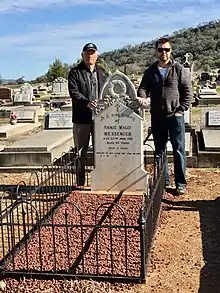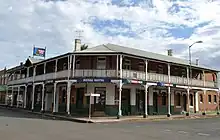Manilla, New South Wales
Manilla is a small town in New South Wales, Australia, located on Fossickers Way 45 kilometres northwest of the regional city of Tamworth and 27 kilometres northeast of the historic village Somerton. Manilla is famous for its setting as a fishing and paragliding area. The name Manilla comes from the Gamilaraay language, and is said to mean 'winding river'.[2]
| Manilla New South Wales | |
|---|---|
 Clock tower in the main street | |
 Manilla | |
| Coordinates | 30°45′0″S 150°43′0″E |
| Population | 2,386 (2021 census)[1] |
| Elevation | 357 m (1,171 ft) |
| Location | |
| LGA(s) | Tamworth Regional Council |
| County | Darling |
| State electorate(s) | Tamworth |
| Federal division(s) | New England |

Manilla was established in the 1850s at the junction of the Namoi River and the Manilla River. It was formerly the centre of Manilla Shire local government area, but this was amalgamated with Tamworth City Council and portions of Parry, Barraba and Nundle Shire Councils to form Tamworth Regional Council in 2004. It lies next to the Bundarra-Barraba Important Bird Area which is important for the conservation of the critically endangered regent honeyeater. Manilla is also well known for Split Rock Dam on the Manilla River and Lake Keepit on the Namoi River.
Services
- Bowling Club
- Caravan Park
- Royal Hotel
- Ambleside B&B Ambleside
- Motel
- Police Station
- Post Office
- Swimming Pool
- Sportsground
- Tennis Courts
- War Memorial Hall, Library and Pre-School
- Fuel Station & Cafe North Store – Manilla
History
The junction of the Manilla and Namoi Rivers was for generations, a camping ground for the local indigenous people, members of the large Kamilaroi (Gamilaraay) tribes of northwestern New South Wales. During the 1850s, teamsters with bullock waggons were regularly transporting goods from the Hunter District through the Manilla area to outlying cattle stations and the northern goldfield settlements of Bingara and Bundarra. Teams were often delayed at the junction of the Namoi and Manilla Rivers by high water. In 1853, enterprising Englishman George Veness arrived at ‘The Junction’ to set up a store and wine shop at the teamsters’ camping ground. In doing so, Veness led the way to town settlement and is acknowledged as the Founder of Manilla. The town's early prosperity was founded on the highly productive wheat and pastoral industries.
Manilla also features a new library centre. Located within the Tamworth Regional Council office in the main street of Manilla, the library is a new type of facility which is known globally as a convergence centre. This means there are many facilities on offer including Centrelink Agency, the Manilla Book Club, a free weekly Storytime for preschool aged children and many other community activities.
Australian singer-songwriter Darren Hanlon immortalised the town of Manilla in his song 'Manilla NSW' which appeared on his 2006 record, 'Fingertips and Mountaintops'.[3]
At the 2006 census, Manilla had a population of 2,082,[4] whilst as at the 2021 census there were 2,386 people.[1]
Rugby League and Dally Messenger

In July 1917 Dally Messenger and his wife, Annie, took over the Royal Hotel in Manilla. Shortly after his arrival Dally established the Manilla Rugby League Club. This was difficult as there was a strong Rugby Union Team and many other young men were at Gallipoli or other theatres of World War I. [5]

His original team included Jack Hiscox, Roy Blanch, Frank and Norman Chapman, Jack Munro and Ivan Miller. Dally played some games but was more concerned, as coach, into forming these local young men into a quality team. In 1918 in the knockout competition held in Tamworth, Manilla defeated Quirindi 10-6 and Tamworth 14 nil. [6][7]
In June 1919 Both Dally and Annie caught the Spanish flu pandemic. Dally recovered but tragically Annie died on 23 June 1919 and is buried in the Manilla cemetery. On 23 August 1919 Dally returned to Sydney with his five year old son (Dally II).[8]
Marking the history on the very day of its formation, 8 July 2017, the Manilla Rugby League club under captain Coach Mitch Doring celebrated its 100th anniversary (2017) of formation with a hard fought match against the Bendemeer Mountain Men whom they defeated 34-30. Guests of honour at the celebratory dinner afterwards included Dally Messenger’s grandsons Ken and Dally Messenger, and great grandchildren Cameron Dally Messenger and Genevieve Ann Messenger.[9]
Heritage listings
Manilla has a number of heritage-listed sites, including:
- Tamworth-Barraba railway: Manilla railway underbridges[10]
Aviation sports
In recent years, Manilla has become famous throughout the world as a major sports flying centre supporting hang gliding, paragliding,[11] ultralight aircraft, gyrocopters and gliders (sailplanes).[12] It boasts nearby Mt Borah, one of the world's best paraglider and hang glider launch sites. In 1998 local paragliding instructor and developer of Mt Borah, Godfrey Wenness, gained the world distance record with a flight of 335 kilometres (208 mi). Major free-flight competitions are staged annually during the summer months. The 10th FAI Paragliding World Championships were held at the site in 2007, attended by 150 pilots from 41 nations. In the week prior to the event Manilla was in the headlines around the world for the survival of paraglider pilot Ewa Wiśnierska of Germany who was sucked up into a thunderstorm to 9,946 metres (32,631 ft). The dramatic story was made into a TV documentary Miracle in the Storm which won an AFI award and was nominated for a Logie Award.
Notable residents
- Henry Burrell (1873–1945), an amateur naturalist, photographer & film-maker, began unlocking the secrets of the platypus.
- Stan Coster (27 May 1930 – 25 March 1997), an Australian country music singer-songwriter.
- Tracy Coster, Australian country music artist, daughter of Stan Coster (above)
- Fiona Coote, aged 14, in 1984 became Australia's second and also its youngest heart transplant recipient.
- Anna Henderson, an ABC News journalist.
- Gavin Coote, an ABC News journalist

Dally Messenger (1883–1959), a rugby league and rugby union player. He came to Manilla in 1917 and held the licence of The Royal Hotel.[5]
- Rod Coote, an Australian indie-pop music singer-songwriter
- Harry M. Miller, entrepreneur, bought the Manilla property "Dunmore" in the 1970s.
- John Quayle, Australian former rugby league CEO, began playing rugby league with Manilla as a boy.
- Anne Rouen, an historical fiction author.[13][14][15][16]
- Godfrey Wenness ASM (1967), paragliding pilot and instructor, developed the Mt Borah airsports facility and school in 1994. Guinness Book of World Records for the longest flight in a paraglider in 1998 (335 km). Australian Sports Medal (2000).
Notes and references
- Australian Bureau of Statistics (28 June 2022). "Manilla (Suburbs and Localities)". 2021 Census QuickStats. Retrieved 17 July 2023.
- "Manilla". Geographical Names Register (GNR) of NSW. Geographical Names Board of New South Wales. Retrieved 27 October 2009.
- "Darren Hanlon Discography". Darren Hanlon. Archived from the original on 20 August 2013. Retrieved 25 March 2013.
- Australian Bureau of Statistics (27 June 2007). "Manilla (State Suburbs)". 2006 Census QuickStats. Retrieved 17 July 2023.
- Fagan, Sean (2007). The master : the life and times of Dally Messenger, Australia's first sporting superstar. Sydney, N.S.W.: Hachette Australia. p. ]317ff. ISBN 9780733622007.
- The Master: Herbert Henry (Dally) Messenger; Historic Plaque, Royal Hotel, Manilla NSW
- Manilla Express, approx, 29 March 1963
- Manilla Express, approx, 29 March 1963
- What a Great Weekend; Manilla Express, Tuesday, 11 July 2017, p.1
- "Manilla railway underbridges". New South Wales State Heritage Register. Department of Planning & Environment. H01045. Retrieved 18 May 2018.
 Text is licensed by State of New South Wales (Department of Planning and Environment) under CC-BY 4.0 licence.
Text is licensed by State of New South Wales (Department of Planning and Environment) under CC-BY 4.0 licence. - Fly Manilla, flymanilla.com.
- Lake Keepit Soaring Club, Gliding at Lake Keepit.
- "2014 Global Ebook Award Winners".
- "2016 Global Ebook Award Winners – Dan Poynter's Global Ebook Awards". globalebookawards.com. Retrieved 16 August 2016.
- Rouen, Anne. "Anne Rouen's Official Website". StoneHut Publishing. Retrieved 17 February 2014.
- Rouen, Anne. "Anne Rouen's Official Achievements Webpage". StoneHut Publishing. Retrieved 17 February 2014.
External links
![]() Media related to Manilla, New South Wales at Wikimedia Commons
Media related to Manilla, New South Wales at Wikimedia Commons
- More History – Manilla Museum Website
![]() Manilla travel guide from Wikivoyage
Manilla travel guide from Wikivoyage